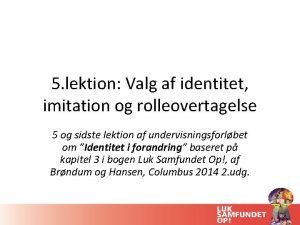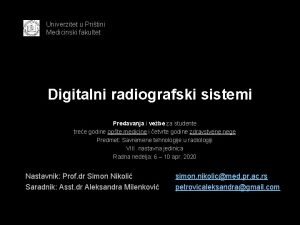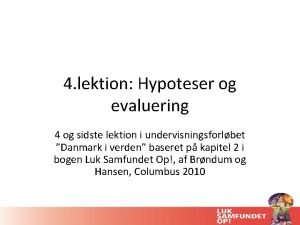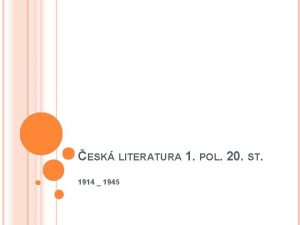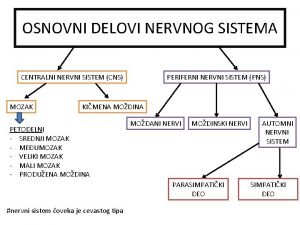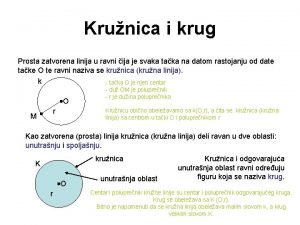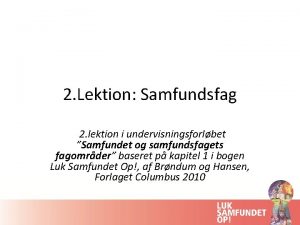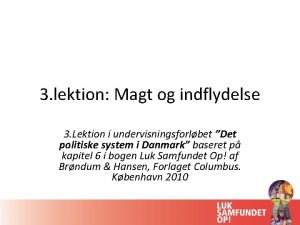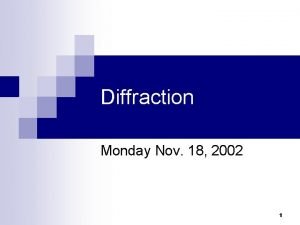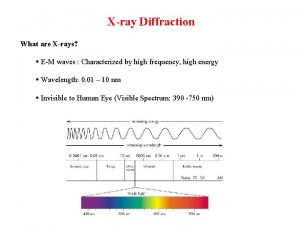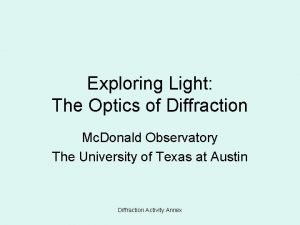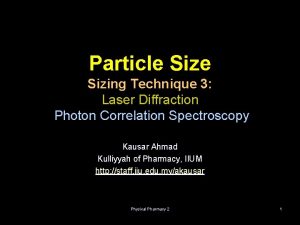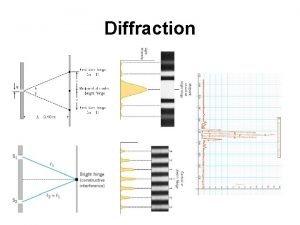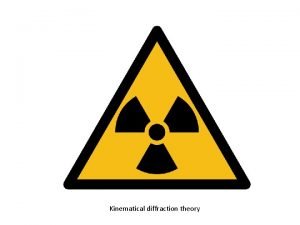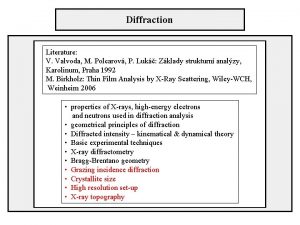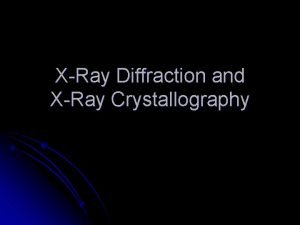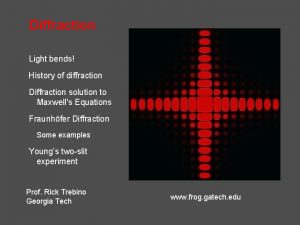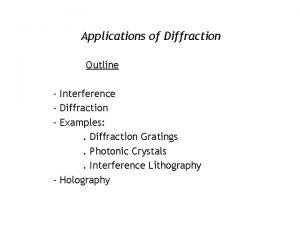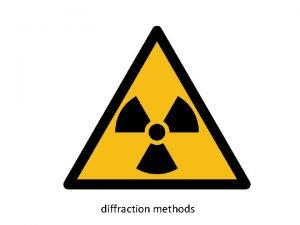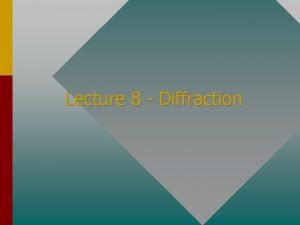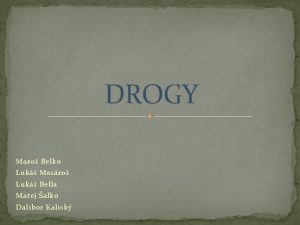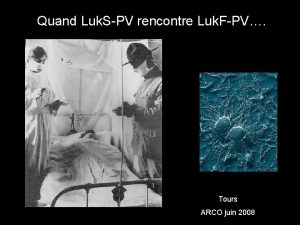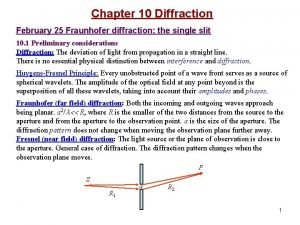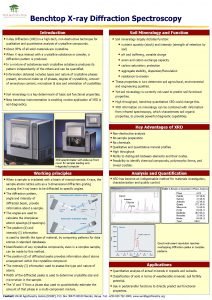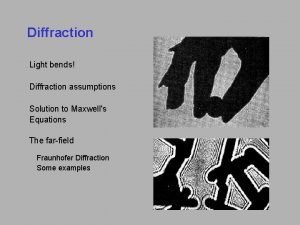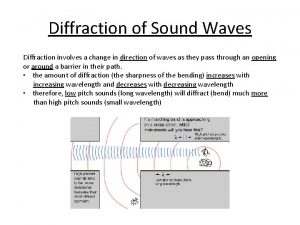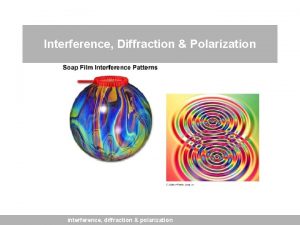Diffraction Literature V Valvoda M Polcarov P Luk
















![Angular dependence of intensity [atomic factor f(S)]2 Interference function S ~ sinθ/λ Angular dependence of intensity [atomic factor f(S)]2 Interference function S ~ sinθ/λ](https://slidetodoc.com/presentation_image_h/1537832309be82101ac65f782e3ccf39/image-17.jpg)














- Slides: 31

Diffraction Literature: V. Valvoda, M. Polcarová, P. Lukáč: Základy strukturní analýzy, Karolinum, Praha 1992 M. Birkholz: Thin Film Analysis by X-Ray Scattering, Wiley-WCH, Weinheim 2006 • properties of X-rays, high-energy electrons and neutrons used in diffraction analysis • geometrical principles of diffraction • Diffracted intensity – kinematical & dynamical theory • Basic experimental techniques • X-ray diffractometry • Bragg-Brentano geometry • Grazing incidence diffraction • High resolution set-up • X-ray topography

Properties of X-rays, electrons and neutrons X-rays electrons neutrons charge 0 -e 0 rest mass 0 9. 1× 10 -31 kg 1. 67× 10 -27 kg energy ~ 10 ke. V ~ 100 ke. V ~ 0. 03 e. V wave length 0. 15 nm 0. 004 nm 0. 12 nm Bragg angles large ~ 1° large extinction length ~ 10 μm 0. 03 μm 100 μm absorption length 100 μm 1 μm 5 cm

Properties of X-rays, electrons and neutrons X-rays electrons rocking curve width 5” refractive index n<1 n>1 n≷ 1 atomic scatt. factors f 10 -4 nm 10 -5 nm dependence of f on Z ~Z anomalous dispersion common spectral width ~ 1 e. V 0. 6° neutrons 0. 5” ~ Z 2/3 – 3 e. V irregular rare 500 e. V

diffraction conditions – Laue equations a, b, c s s 0 Laue equations

Concept of reciprocal lattice scattering vector reciprocal basis vectors reciprocal lattice vectors

Concept of reciprocal lattice conditions for diffraction are fulfilled properties of reciprocal lattice vectors

Concept of reciprocal lattice (120)

Looking for solution s/λ X-ray tube s 0/λ 1/λ

Ewald construction reciprocal lattice Ewald sphere s/λ X-ray tube s 0/λ sample polycrystalline samples 1/λ origin of RL Ewald construction is a graphical presentation of the solution of Laue equations

Lattice planes in two-dimensional lattice dhkl

Bragg’s law diffraction triangle θ dhkl d sinθ Miller indices (110) (hkl) diffraction indices 110, 220, 440 hkl

Extinction length ξ Extremely important parameter D Dimension of coherent region << ξ kinematical theory Dimension of coherent region ≥ ξ dynamical theory

Diffracted intensity Kinematical theory of diffraction – 1 st Born approximation hierarchy of scattering – calculation of amplitude electron – scattering length be (scattering amplitude) ~ classical radius of electron (Thomson) [m] re = 2. 82× 10 -6 nm intensity of unpolarized radiation scattered by one free electron

Diffracted intensity atom – atomic form factor f – integration over the volume of atom absolute units electron units Cromer-Mann coefficients ai, bi, c– tabulated f ’, f ” corrections for anomalous dispersion for electrons

Diffracted intensity unit cell – structure factor F(S) – summation over all atoms in cell xj, yj, zj – fractional coordinates Debye-Waller factor – mean squared displacement Bj – temperature factors tabulated extinction rules type of lattice, symmetry elements

Diffracted intensity whole lattice – summation over all unit cells interference function for intensity lattice factor intensity scattered by the whole crystal – interference function fundamental equation
![Angular dependence of intensity atomic factor fS2 Interference function S sinθλ Angular dependence of intensity [atomic factor f(S)]2 Interference function S ~ sinθ/λ](https://slidetodoc.com/presentation_image_h/1537832309be82101ac65f782e3ccf39/image-17.jpg)
Angular dependence of intensity [atomic factor f(S)]2 Interference function S ~ sinθ/λ

YBCO/sapphire 001 002 003

Measured intensity maximum intensity Integral intensity area of the peak for small single crystalline sample phkl = 1 Lp – Lorentz-polarization factor for small single crystalline sample for polycrystalline sample phkl = multiplicity factor V – irradiated volume for polycrystalline sample quantitative analysis!

Parameters of diffraction peaks FWHM or integral breadth β is affected by • instrumental broadening – g(2θ) • crystallite size – β ~ λ/(D cosθ) (Scherrer equation) • microstrain – β ~ tanθ • planar lattice defects (stacking faults, antiphase boundaries) convolution of line profiles Gaussian Cauchy – Lorentz

Dynamical theory of diffraction for (nearly) ideal large single crystals Solution of wave equation in periodic medium (dielectric susceptibility) refraction od X-rays – multiple diffraction – n=1–δ δ ~ 10 -5 ÷ 10 -6 interaction of diffracted and primary beam Intensity I ~ |F(S)|

Rocking curve – perfect crystal, Bragg case Darwin curve Prins curve typical values of W: Si 004, Cu Kα 1 Si 333, Mo Kα 1 Ga. As 004, Cu Kα 1 3. 83 " 0. 73 " 8. 55 "

Debye-Scherrer method measuring of lattice parameters of powder samples with high precision

Laue method orientation of single crystals Laue – 1912 FMFI UK – 1992

X-Ray diffractometry X-ray sources • sealed tubes ~ 1. 5 k. W • rotating anodes ~ 18 k. W • synchrotron by orders of magnitude higher goniometer measuring the angles with precision ~ 0. 0001° PC controll detectors • point – 0 D • linear – 1 D • area – 2 D (films)

Absorption of X-rays t I 0 I Lambert-Beer law μ – attenuation coefficient β filter

Symmetric θ/2θ (2θ/θ) measurement incident beam diffracted beam θ θ sample 2θ sample surface 2 configurations of diffractometers – horizontal or vertical set-up • fixed sample, moving X-ray tube and detector (θ-θ) • fixed tube, moving sample (θ) and detector (2θ), ratio of speeds – 1: 2

Diffraction in symmetric set-up primary beam Diffracting planes – parallel to the sample sufrace Each diffraction originates from different assembly of crystallites

Bragg-Brentano set-up focussing circle detector slit goniometer axis sample focus of X-ray tube Divergent primary beam irradiates the sample. All beams diffracted at different parts of the sample are focused at the detector slit.

Diffraction pattern of Mg. B 2 wire in Ti sheath Mg. B 2 and Mg. O phases are identified. Some peaks of Ti are also present. Red line is the simulated curve provided by software TOPAS 3. 0 of Bruker company.

 Matrixgruppe
Matrixgruppe Rolleovertagelse
Rolleovertagelse 100-lük kvadrat cədvəli
100-lük kvadrat cədvəli Luk vanhauwaert
Luk vanhauwaert C luk rtg
C luk rtg Wayne luk imperial
Wayne luk imperial El luk
El luk Luk samfundet op
Luk samfundet op Luk jenž od západu napíná se
Luk jenž od západu napíná se Wielki łuk braterstwa
Wielki łuk braterstwa Mozdinski nervi
Mozdinski nervi Rastojanje
Rastojanje Mok sal
Mok sal Gotička umetnost
Gotička umetnost Luk samfundet op
Luk samfundet op Luk samfundet op
Luk samfundet op Lukas 15: 11-32
Lukas 15: 11-32 A nazváno buď prostou chatrčí
A nazváno buď prostou chatrčí Luk samfundet op
Luk samfundet op Mitsubishi electric zubadan
Mitsubishi electric zubadan živočíchy spoločenstva lúk
živočíchy spoločenstva lúk Lukas 5:17-26
Lukas 5:17-26 Luk samfundet op
Luk samfundet op Spolocenstvo luk
Spolocenstvo luk Luk katalog
Luk katalog Fraunhofer and fresnel diffraction
Fraunhofer and fresnel diffraction Xray waves examples
Xray waves examples Diffraction
Diffraction Laser diffraction spectroscopy
Laser diffraction spectroscopy Diffraction grating
Diffraction grating Dispersive power of grating
Dispersive power of grating Kinematical diffraction
Kinematical diffraction

